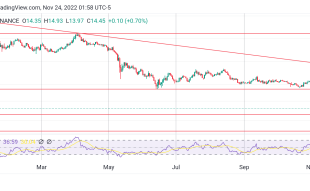Join Our Telegram channel to stay up to date on breaking news coverage
Is it possible for crypto to completely die? The answer is, only if everyone abandoned it; that would be the only way that crypto would go to zero. The journey, however, is more interesting than the destination. The demise of FTX, an exchange declared bankrupt on November 11th following a spectacular blow-up, will encourage some people to look elsewhere. What would have to occur in order for everyone to give up?
How crypto works
An answer necessitates an understanding of how the industry operates. Blockchains, such as Bitcoin and Ethereum, are at the heart of crypto, recording transactions verified by computers, a process incentivized by the issuance of new tokens. The Ethereum blockchain validates lines of code, allowing people to create their own tokens and applications. Stablecoins, which are pegged to real-world currencies, and tokens like Uniswap, which manage decentralized finance (DeFi) protocols, are examples of these. 90% of cryptocurrency value is accounted for by major chains and a handful of Ethereum-based tokens such as stablecoins. On top of this world, large businesses such as exchanges, investment funds, and lending platforms have been built.
To completely eliminate crypto, the underlying blockchain layers would have to be destroyed. They could either give way first, kicking the stool out from underneath everything else, or they could both give way at the same time. Or, like a knitted scarf, the industry could unravel from the top down.
The stool is extremely difficult to remove, and the current high value of bitcoin and ether makes it even more difficult. To attack and shut down a blockchain, you must gain 51% control of the computational power or value of tokens staked to verify transactions. The more valuable the tokens, the more energy required to attack a proof-of-work chain, such as Bitcoin, and the more money required to attack a proof-of-stake chain, such as Ethereum. The security of these chains, as measured by the amount of money required to attack them, is now in the $5 billion to $10 billion range. Such an attack would require either a government or an extremely wealthy individual. Even if Elon Musk was interested, he appears to be very busy right now.
Unraveling
Unraveling is thus the more plausible option. The events of this year have demonstrated how susceptible crypto is to this type of thing. Terra-Luna, a decentralized stablecoin system worth around $40 billion at its peak, appears to have triggered the chaos. It crashed in May, erasing $200 billion from the crypto market capitalisation. This resulted in the bankruptcy of several lending platforms and a hedge fund a few weeks later, wiping another $200 billion off the market cap. Margin calls on these platforms appear to have jeopardized Alameda, the trading firm owned by Sam Bankman-Fried, prompting the decision to use ftx customer funds to bridge the gap. When ftx failed, the crypto market cap lost another $200 billion. Other exchanges and lending platforms appear to be in trouble now.
Readers with keen eyes will notice that, with the exception of Terra-Luna, the majority of this technology is “on top of” rather than “on-chain.” DeFi exchanges and lending protocols have continued to operate even as traditional businesses have imploded one by one. However, the failure of these businesses could jeopardize the underlying technology by removing chunks of its value, making the chains more vulnerable to would-be attackers, and forcing miners or stakeholders to turn off their machines. The value of on-chain activity and tokens reinforces itself. The greater the number of people who use DeFi, the more valuable Ethereum becomes. The higher the price of ether, the higher the barrier to attack the blockchain and the greater people’s confidence that blockchains will survive. This also works in the opposite direction. The more people who avoid cryptocurrency out of fear, the less secure it becomes.
The half-full glass: crypto is still high and powerful by historical standards
The total market capitalization of cryptocurrencies is currently $820 billion. That is 70% lower than the peak a year ago, but still high when compared to the majority of crypto’s history. It is higher than it was at the start of last year, and any point prior to that, including the peak of the bull market in 2017. Many more layers, such as a major stablecoin, large businesses, or possibly other on-chain protocols, would have to be untangled in order to restore crypto’s value to where it was three or four years ago. Crypto’s reputation has previously been harmed. Throughout its existence, its value has repeatedly collapsed. Although fewer people will use cryptocurrency as a result of the ftx crash, it is difficult to imagine the number being small enough to reduce its value to zero.
Related
- Industry experts predict “Zero” for the Terra Classic price in their article “Is LUNC Dead?”
- Genesis Teetering on The Edge After FTX Collapse – Withdrawals Stopped
- Andreessen Horowitz Predicts A Fourth Bull Cycle for Crypto
Join Our Telegram channel to stay up to date on breaking news coverage


